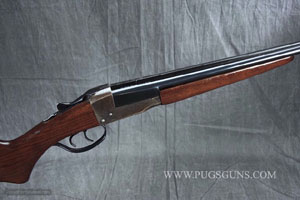

Initially, the 620 was only offered in 12 gauge but a 16 gauge followed in 1928 and a 20 gauge was introduced in 1930. The stock was attached by a bolt connecting the receiver and trigger tangs through the grip of the stock. The safety was initially located inside the trigger housing just like the Model 520 but by 1929 it had been changed to a cross-bolt located behind the trigger. The Model 620 was introduced in 1927 and is a streamlined version of the original 520. All model 520s were only offered in 12 gauge until 1928. The action was designed to only unlock after firing or with the use of the slide release and not by dry firing like many modern shotguns. This inertial release uses the recoil of a discharged round to unlock the breech. Internally there is an inertial slide release block that is affixed to the inside of the receiver.

There were other models including a Model 522 trap gun and the 525, 530, and 535 with increasing levels of engraving and stock quality (some straight grip) and foregrips. The cartridge stop is a rocker design with a set screw on the front right side of the receiver. The trigger housing is retained with three screws and the safety is a lever located inside the trigger guard in front of the trigger. The foregrip is ringed and uniform in size. It has a round slide release knob on the left side of the receiver, a visible breach locking bolt on the top of the receiver, and base models have a rounded pistol grip on the buttstock. It is easily recognizable by its "humpback" double receiver. 52 and was also offered for sale in the fall 1909 Sears & Roebuck catalog. The first Stevens 520 appeared in Stevens' 1909 Catalog No. All models can also be slam fired: the shotgun has no trigger disconnector and shells can be fired one after the other simply by working the slide if the trigger is held down. This shotgun is a hammerless, pump action, take-down design with a tubular magazine which holds 5 shells. The Model 620 was internally similar to the Model 520 and was produced until 1939 when it was replaced by the Model 620A which ended production in 1955. Stevens also further modified the design when they introduced the streamlined Model 620 in 1927. Under Savage ownership, Model 520 production continued until 1939 when it was replaced by the Model 520A which ended production in 1948.
#J stevens arms serial number lookup full#
After the war, Stevens was sold to Savage Arms on 1 April 1920 and full production of civilian firearms resumed. The company was renamed the "J Stevens Arms Company" on 1 July 1916 and New England Westinghouse used their manufacturing facility in Chicopee Falls, MA to produce Mosin-Nagant rifles under contract for the Russian Czar during World War I. Stevens was sold to New England Westinghouse on and production of civilian firearms was greatly reduced. The Stevens Model 520 was a pump-action shotgun developed by John Browning and originally manufactured by the J Stevens Arms & Tool Company between 19. Stevens Arms Co/Savage Arms Co (1916-1955)


 0 kommentar(er)
0 kommentar(er)
